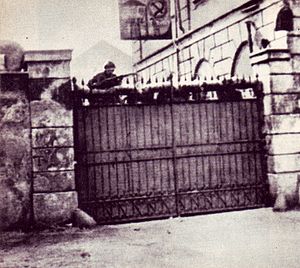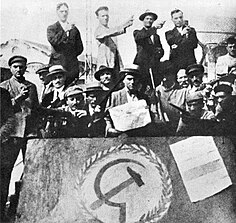Biennio Rosso
| Biennio Rosso | |||
|---|---|---|---|
| Part of the Revolutions of 1917–23 | |||
 Armed workers occupying factories in Milan, September 1920 | |||
| Date | 1919–1920 | ||
| Location | |||
| Caused by | The economic crisis in the Aftermath of World War I, with high unemployment and political instability | ||
| Methods | Mass strikes, worker manifestations as well as self-management experiments through land and factory occupations | ||
| Resulted in | The revolutionary period was followed by the violent reaction of the Fascist blackshirts militia and eventually by the March on Rome of Benito Mussolini in 1922. | ||
| Parties to the civil conflict | |||
| |||

The Biennio Rosso (English: "Red Biennium" or "Two Red Years") was a two-year period, between 1919 and 1920, of intense social conflict in Italy, following the First World War.[1] The revolutionary period was followed by the violent reaction of the Fascist blackshirts militia and eventually by the March on Rome of Benito Mussolini in 1922.
Background[]
The Biennio Rosso took place in a context of economic crisis at the end of the war, with high unemployment and political instability. It was characterized by mass strikes, worker manifestations as well as self-management experiments through land and factories occupations.[1] Tension had been rising since the final years of the war. Some contemporary observers considered Italy to be on the brink of a revolution by the end of 1918.[2]
The population was confronted with rising inflation and a significant increase in the price of basic goods, in a period that extensive unemployment was aggravated by mass demobilization of the Royal Italian Army at the end of the war. Association to the trade unions, the Italian Socialist Party (PSI), and the anarchist movement increased substantially. The PSI increased its membership to 250,000, and the major Socialist trade union, the General Confederation of Labour (Confederazione Generale del Lavoro, CGL), reached two million members, while the anarchist Italian Syndicalist Union (Unione Sindacale Italiana, USI) reached between 300,000 and 500,000 affiliates. The vigour of the anarchists was boosted by the return from exile of the anarchist leader Errico Malatesta in December 1919.[3][4]
Events[]
In Turin and Milan, factory councils – which the leading Italian Marxist theoretician Antonio Gramsci considered to be the Italian equivalent of Russia’s soviets[5] – were formed and many factory occupations took place under the leadership of revolutionary socialists and anarcho-syndicalists.[6][better source needed] The agitations also extended to the agricultural areas of the Padan plain and were accompanied by peasant strikes, rural unrests and armed conflicts between left-wing and right-wing militias.
Industrial action and rural unrest increased significantly: there were 1,663 industrial strikes in 1919, compared to 810 in 1913. More than one million industrial workers were involved in 1919, three times the 1913 figure. The trend continued in 1920, which saw 1,881 industrial strikes. Rural strikes also increased substantially, from 97 in 1913 to 189 by 1920, with over a million peasants taking action.[7][8] On July 20-21, 1919, a general strike was called in solidarity with the Russian Revolution.[6]
In April 1920, Turin metal-workers, in particular at the Fiat plants, went on strike demanding recognition for their 'factory councils', a demand the PSI and CGL did not support. The 'factory councils' more and more saw themselves as the models for a new democratically controlled economy running industrial plants, instead of as a bargaining tool with employers.[2] The movement peaked in August and September 1920. Armed metal workers in Milan and Turin occupied their factories in response to a lockout by the employers. Factory occupations swept the "industrial triangle" of north-western Italy. Some 400,000 metal-workers and 100,000 others took part.[2][9] On September 3, 185 metal-working factories in Turin had been occupied.[10]
The PSI and CGL failed to see the revolutionary potential of the movement; had it been maximized and expanded to the rest of Italy, a revolutionary transformation might have been possible. Most Socialist leaders were pleased with the struggles in the North, but did little to capitalize on the impact of the occupations and uprisings. Without the support and quarantined, the movement for social change gradually waned.[2]
Aftermath[]
By 1921, the movement was declining due to an industrial crisis that resulted in massive layoffs and wage cuts. In contrast to passive demeanor the PSI and CGL, employers and the upcoming fascist did react.[2] The revolutionary period was followed by the violent reaction of the Fascist blackshirts militia (the Fasci Italiani di Combattimento) and eventually by the March on Rome of Benito Mussolini in October 1922.[2][9]
A quantitative sociological study of the period by analyzing newspaper news in the period[11] (see figure) clearly demonstrates the evolution of violence acts between the social groups involved.
See also[]
- Revolutions of 1917–23
- Aftermath of World War I
- March on Rome
- Benito Mussolini
- Fascist and anti-Fascist violence in Italy (1919–1926)
References[]
- ^ Jump up to: a b Brunella Dalla Casa, Composizione di classe, rivendicazioni e professionalità nelle lotte del "biennio rosso" a Bologna, in: AA. VV, Bologna 1920; le origini del fascismo, a cura di Luciano Casali, Cappelli, Bologna 1982, p. 179.
- ^ Jump up to: a b c d e f Pelz, Against Capitalism, pp. 126-28
- ^ Biennio Rosso (1919–1920) in: Ness, Immanuel (2009). The International Encyclopedia of Revolution and Protest, Blackwell Publishing, ISBN 978-1-405-184649
- ^ Di Paola, Pietro, 1966-. The knights errant of anarchy : London and diaspora of Italian anarchist diaspora (1880-1917). Liverpool. p. 203. ISBN 1781385645. OCLC 864395167.CS1 maint: multiple names: authors list (link)
- ^ Bellamy & Schecter, Gramsci and the Italian State, p. 29
- ^ Jump up to: a b 1918-1921: The Italian factory occupations and Biennio Rosso at libcom.org
- ^ Gramsci: the Turin years, by Megan Trudell, International Socialism No. 114, April 2007
- ^ Neufeld, Italy: school for awakening countries, p. 547
- ^ Jump up to: a b A Marxist History of the World part 76: Italy’s 'Two Red Years', Counterfire, May 20, 2012
- ^ Bellamy & Schecter, Gramsci and the Italian State, pp. 51-52
- ^ Quantitative Narrative Analysis (Quantitative Applications in the Social Sciences). Roberto Franzosi, Beverly Hills, CA: Sage, 2010.
- Bellamy, Richard Paul & Darrow Schecter (1993). Gramsci and the Italian State, Manchester/New York: Manchester University Press, ISBN 0-7190-3342-X
- Neufeld, Maurice F. (1961). Italy: school for awakening countries - The Italian labor movement in its political, social, and economic setting from 1800 to 1960, New York State School of Industrial and Labor Relations, Cornell University.
- Pelz, William A. (2007). Against Capitalism: The European Left on the March, New York: Peter Lang, ISBN 978-0-8204-6776-4
Further reading[]
- Giuseppe Maione, Il biennio rosso. Autonomia e spontaneità operaia nel 1919-1920, Bologna, , 1975
- Giovanni Sabbatucci (a cura di), La crisi italiana del primo dopoguerra. La storia e la critica, Bari, , 1976
- AA. VV., Le rivoluzioni sconfitte, 1919/20, a cura di Eliana Bouchard, Rina Gagliardi, Gabriele Polo, supplemento a "il manifesto", Roma, s.d. (ma 1993)
- Roberto Bianchi, Pace, pane, terra. Il 1919 in Italia, Rome, Odradek Edizioni, 2006
- Fabio Fabbri, Le origini della guerra civile. L'Italia dalla Grande Guerra al fascismo. 1918-1921, Torino, , 2009.
External links[]
- Political history of Italy
- Anarchism in Italy
- 1919 in Italy
- 1920 in Italy
- 1919 labor disputes and strikes
- 1920 labor disputes and strikes
- Riots and civil disorder in Italy
- Labor disputes in Italy
- Revolutions of 1917–1923